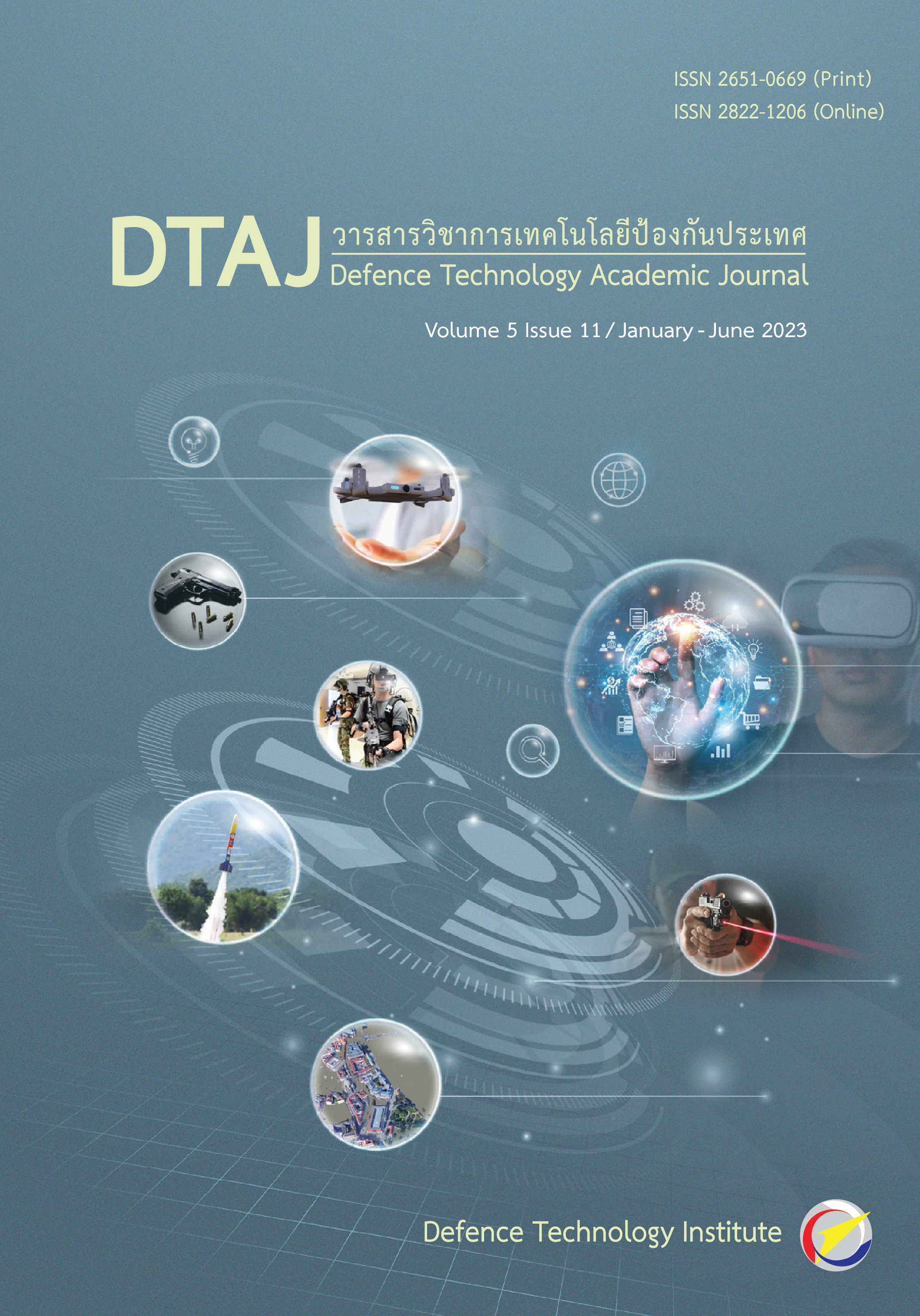Satisfaction With The Flood Simulation System Case Study: Tha Wanga Pha District, Nan Province
Main Article Content
Abstract
The purpose of this study was to assess the satisfaction with the Flood Simulation System used by Mobile Development Unit 31 in Tha Wang Pha District, Nan Province, as a military tool for Intelligence Preparation of the Battlefield (IPB). It consists of four steps: 1) determining the environment of the flood situation area; 2) explaining the impact of the flood situation; 3) evaluating the threat from the flood situation; and 4) considering how to deal with the flood situation classified by personal data. The questionnaire was used as a tool for collecting data.
As a result of the personal data assessment, males accounted for 93.3 percent of participants, and females accounted for 6.7 percent. In terms of age, the majority were between the ages of 30 and 40, and those between the ages of 41 and 50 accounted for 40 percent. In terms of experience in disaster relief and disaster management, it was found that most of them had experience for less than 8 years, representing 56.7 percent. As for the results of the satisfaction survey on the use of the flood simulation system, considering the environmental conditions of the flood situation area, there were mostly positive feedbacks and almost no negative feedbacks. In terms of being a military tool to help explain the impact of the flood situation and as a military tool to help assess the threat from the flood situation, this has the most satisfactory assessment result. Therefore, it can be concluded that Mobile Development Unit 31 was satisfied with the use of the flood simulation system in Tha Wang Pha District, Nan Province, as a military tool for intelligence preparation of the battlefield. The satisfaction value is 4.18, while the standard deviation is 0.64, which indicates good and acceptable cohesion.
Downloads
Article Details

This work is licensed under a Creative Commons Attribution-NonCommercial-NoDerivatives 4.0 International License.
Journal of TCI is licensed under a Creative Commons Attribution-NonCommercial-NoDerivatives 4.0 International (CC BY-NC-ND 4.0) licence, unless otherwise stated. Please read our Policies page for more information...
References
ร. รัตนโสภนณ์, “เอกสารประกอบการบรรยาย เรื่อง Intelligence Preparation of the Battlefield,” หน่วยบัญชาการทหารพัฒนา, กรุงเทพมหานคร, ไทย, 2563.
H. Adikari, S. Agalakumbura, and J. Jayamaha, “Automation of Intelligence Preparation of the Battlefield,” Final Year Project, Dept. Comput. Eng., Univ., Peradeniya, Sri Lanka, 2020.
P. Skalický and T. Palasiewicz, “Intelligence Preparation of the Battlefield as a Part of Knowledge Development,” Int. Conf. Knowl. Based Organ., vol. 23, no. 1, pp. 276-280, 2017, doi: 10.1515/kbo-2017-0045.
L. J. Snider, “An Assessment of Intelligence Preparation of the Battlefield Doctrine for Humanitarian Assistance Operations,” School Adv. Mil. Stud., Fort Leavenworth, Kansas, USA, Rep.19960617 022, 1995.
C. Grindle, M. Lewis, R. Glinton, J. Giampapa, S. Owens, and K. Sycara, “Automating Terrain Analysis: Algorithms for Intelligence Preparation of the Battlefield,” Proc. Hum. Factors Ergon. Soc. Annu. Meet., vol. 48, no. 3, pp. 533 - 537, Sep. 2004, doi: 10.1177/154193120404800355.
W. Pimpa, S. Sarapirome, and S. Dasananda, “GIS Application to Development of Military Cross-country Movement Maps at Mae Sot District, Western Thailand,” Suranaree J. Sci. Technol., vol. 21, no. 3, pp. 215 - 232, 2014.
พ. เหมวรรณ, อ. เจริญปัญญาเนตร, ภ. สิงห์คำฟู, จ. สุขพินิจ และ จ. สีแดง, “การจำลองระดับน้ำท่วม ด้วยข้อมูลแบบจำลองความสูงเชิงเลขจากการ บินถ่ายด้วยระบบอากาศยานไร้คนขับ: กรณีศึกษา อำเภอท่าวังผา จังหวัดน่าน,” วารสารวิชาการ เทคโนโลยีป้องกันประเทศ, ปีที่ 3, ฉบับที่ 9, น. 108 - 118, ม.ค. - มิ.ย. 2565.


